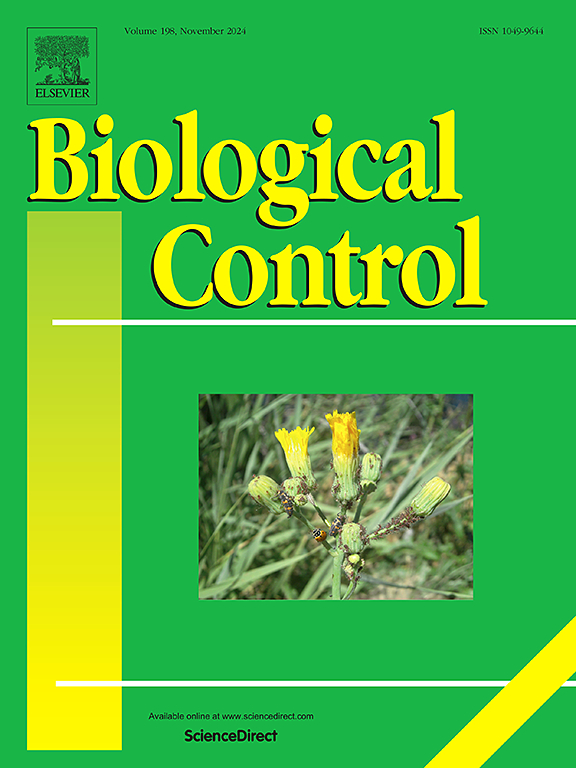生物防治剂与寄主植物抗性的配伍性及其防治南美番茄蛲虫的研究
IF 3.4
2区 农林科学
Q2 BIOTECHNOLOGY & APPLIED MICROBIOLOGY
引用次数: 0
摘要
将寄主植物抗性与生物防治剂结合起来是一种很有前景的可持续治理策略,可以有效地防治对番茄生产构成重大威胁的入侵害虫——绝对番茄蚜(Phthorimaea (Tuta) absoluta (Meyrick)(鳞翅目:Gelechiidae)。然而,番茄的形态抗性性状、次生代谢物和植物挥发物可能对天敌产生不利影响,从而影响害虫防治的整体效果。本研究评估了三种天敌在6种番茄基因型中表现出不同程度对绝对白僵菌抗性的表现。首先,我们评估了拟寄生虫赤眼蜂(Trichogramma achaeae)对不同基因型番茄上的飞蛾卵的寄生性能,包括分离卵和在不同番茄小叶上的卵。其次,我们评估了拟寄生蜂对番茄基因型中绝对白僵菌幼虫的寄生性能。最后,我们研究了杂种小蠹蛾对不同基因型番茄的捕食能力,以及对不同基因型番茄的捕食若虫的存活率。番茄的寄生率和羽化率、天敌若虫的捕食效率和成虫的存活率均无显著影响。而抗药的野生龙葵对两种寄生蜂的寄生性能均有负面影响,降低了一龄若虫的捕食效能和存活率,延长了捕食若虫的发育时间。我们的研究结果表明,抗性基因型Corona F1和S. neorickii似乎与所有天敌都是相容的,而S. arcanum则是不相容的。本文章由计算机程序翻译,如有差异,请以英文原文为准。

Compatibility of biocontrol agents with host plant resistance for management of the South American tomato pinworm Phthorimaea absoluta
Integrating host plant resistance with biocontrol agents represents a promising strategy for sustainable management of Phthorimaea (Tuta) absoluta (Meyrick) (Lepidoptera: Gelechiidae), an invasive pest that poses a significant global threat to tomato production. However, morphological resistance traits, secondary metabolites, and plant volatiles in tomato may have adverse effects on natural enemies, thereby influencing the overall efficacy of pest control. This study evaluated the performance of three natural enemies across six tomato genotypes exhibiting various levels of resistance to P. absoluta. First, we evaluated the performance of the parasitoid Trichogramma achaeae on eggs, derived from moths reared on the different tomato genotypes, both in isolation and when presented on respective tomato leaflets. Second, we assessed the performance of the parasitoid Necremnus tutae on tomato genotypes that hosted P. absoluta larvae. And finally, we investigated the predatory capacity of the mirid Macrolophus pygmaeus on tomatoes hosting eggs and larvae of P. absoluta, all derived from moths reared on these genotypes, as well as the survival of predator nymphs on the different tomato genotypes, both with and without P. absoluta eggs. The P. absoluta-susceptible tomatoes, the resistant domesticated Corona F1 and the resistant wild tomato species Solanum neorickii had no significant impact on the parasitism and emergence rates of both parasitoids, or on the predatory efficacy and survival of predator nymphs. In contrast, the resistant wild Solanum arcanum negatively affected the performance of both parasitoids, reduced predatory efficacy and survival of first-instar nymphs, and increased the development time of predator nymphs. Our findings indicate that the resistant genotypes Corona F1 and S. neorickii appears to be compatible with all the natural enemies, whereas S. arcanum appears incompatible.
求助全文
通过发布文献求助,成功后即可免费获取论文全文。
去求助
来源期刊

Biological Control
生物-昆虫学
CiteScore
7.40
自引率
7.10%
发文量
220
审稿时长
63 days
期刊介绍:
Biological control is an environmentally sound and effective means of reducing or mitigating pests and pest effects through the use of natural enemies. The aim of Biological Control is to promote this science and technology through publication of original research articles and reviews of research and theory. The journal devotes a section to reports on biotechnologies dealing with the elucidation and use of genes or gene products for the enhancement of biological control agents.
The journal encompasses biological control of viral, microbial, nematode, insect, mite, weed, and vertebrate pests in agriculture, aquatic, forest, natural resource, stored product, and urban environments. Biological control of arthropod pests of human and domestic animals is also included. Ecological, molecular, and biotechnological approaches to the understanding of biological control are welcome.
 求助内容:
求助内容: 应助结果提醒方式:
应助结果提醒方式:


